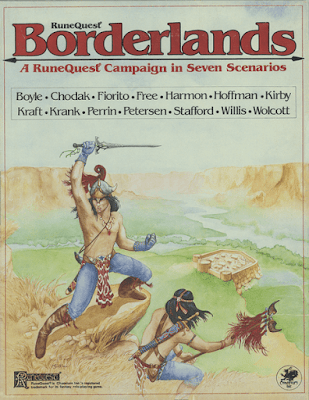In the various campaigns I've refereed over the years, I almost always establish the existence of at least one large city. In the Emaindor campaign of my youth, there was the city of Zwardzand – a No-Prize to anyone who recognizes where I stole that from – and, in my Dwimmermount campaign, there was the city-state of Adamas. In both campaigns, the cities in question were never focal points; the player characters visited them for brief times but rarely stayed for long. Thus, the itch to referee an urban fantasy campaign after the fashion of Leiber's stories has never come to pass. Nevertheless, my interest in refereeing such a campaign in unabated and I continue to think about the possibility of undertaking it one day.
The first RPG product I ever encountered that seemed geared to supporting such a thing was The Free City of Haven by Gamelords. No doubt some of you reading this will ask, not unreasonably, "What about City State of the Invincible Overlord?" Fond as I am of that venerable Judges Guild product, CSIO doesn't quite have the feel I'd want for such a campaign. It's too much of a kitchen sink, filled with monsters and other oddities that, while terrific for a certain style of fantasy, seem at odds with the noir-tinged sword-and-sorcery escapades of Fafhrd and the Gray Mouser. Tastes differ, of course, but, for me, The Free City of Haven came closest to doing what I wanted.
First published in 1981, Haven was presented as a large collection of three-hole punched pages in a ziplock bag, along with many maps – not too dissimilar from the format of Thieves' Guild, published the previous year. Employing two columns and a tiny font, Haven is positively bursting with information, which is what wowed me about it when I first saw it. In addition to all the usual information you'd expect, such as a history of the city and descriptions of the major factions, it details innumerable NPCs, both major and minor. They run the gamut from influential members of the various powerful families that control aspects of the city to business owners, guards, urchins, and more.
In many ways, the NPCs are the heart and soul of Haven. While the product details each of the ciy's boroughs with information on significant buildings, it's the NPCs – or "personalities," as the text calls them – that bring the place to life. Reading through the entries, one feels as if Haven is populated by real people. Each described NPC has a name and game statistics, of course, but, more importantly, he has individuality. This helps the referee in portraying him and his role in the city, as well as the NPC's interests and goals, many of which are vital to spinning adventures within the city.
This NPC-centric approach was, I think, a novel one at the time. While there are plenty of descriptions of buildings and locations, they don't form the bulk of Haven's text. Instead, the emphasis is solidly on Haven's inhabitants and how they fit into the larger picture of this independent and faction-ridden city. For that reason, Haven provides many examples of encounters or scenarios to be had within the walls of the city. These vary considerably in size and complexity, with some being the kind of thing a referee could easily use to enliven a few minutes and others being the basis for an extended series of sessions. This is in addition to an extensive random encounter table that's divided up by city borough.
If I have a complaint about The Free City of Haven, it's that there so much material packed in its loose pages that it can be very hard to keep track of it all. At the time, when I was more mentally agile, this didn't bother me and I had little trouble remembering where to find the details I required. Nowadays, though, it's a fair bit harder to use. In that respect, it's very much an amateur product, especially when compared to the publications of TSR or Chaosium from the same time period. I know that a second edition of Haven was published as a boxed set in 1984, but, not having seen it, I can't speak to whether it also included an easier to use presentation. Even if it didn't, there can be little doubt that The Free City of Haven is a gem from the first decade of the hobby, a useful and imaginative fantasy RPG product I continue to admire. If I ever do get around to running an urban fantasy campaign, you can be sure I'll be taking a look at The Free City of Haven for inspiration.






















